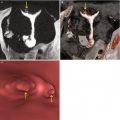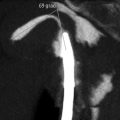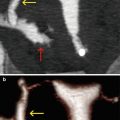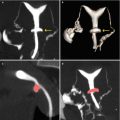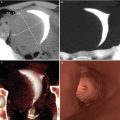, Carlos Capuñay1, Carlos E. Sueldo2 and Juan Mariano Baronio3
(1)
Diagnóstico Maipú, Buenos Aires, Argentina
(2)
University of California, San Francisco, CA, USA
(3)
CEGYR, Buenos Aires, Argentina
Virtual Hysterosalpingography (VHSG) is a new non-invasive technique that evolved from our group’s prior experience with virtual colonoscopy studies [1]; as stated in prior publications [2], it allows us to evaluate the entire gynecologic tract in a single study, including the cervix, uterus [3] and fallopian tubes [4].
Infertile patients, unable to achieve conception after 12 months of unprotected intercourse, could benefit from VHSG, as many of the causes of infertility will be tested in great detail, as we will show in the present chapter. The causes of infertility are due to female causes in 40 % of the cases, male factor in 30 % and shared causes in 15 %; unexplained infertility is found in 15 %, and is encountered when a full evaluation of the infertile couple fails to identify abnormal studies. Table 15.1, shows the list of the most common factors involved in female infertility.
Table 15.1
Female causes of infertility
Tuboperitoneal factor | 30 % |
Ovulation problems | 40 % |
Cervical factor | 10 % |
Luteal phase disorders | 5 % |
Uterine factor | 5 % |
Idiopathic factors | 10 % |
The diagnostic studies play an important role in the definition and diagnosis of the multiple causes of infertility, and as such, help us decide on the best therapeutic management, according to the type of pathology encountered [5, 6]. Focusing on the female factors, the diagnostic tests ought to determine whether the fallopian tubes are abnormal, as if they were, the transport of gametes and embryos will be compromised; also, the pathology of the uterus itself, inside the cavity as well as on the uterine wall, may be responsible for the patient’s inability to get pregnant.
At present, the imaging studies that are most commonly performed in the infertile female patient, are the vaginal ultrasound and the conventional hysterosalpingography (HSG). Other studies, like MRI, are used to help or confirm the data initially obtained in patients with suspected endometriosis, adenomyosis, myomas or uterine malformations; also, performing a diagnostic in-office hysteroscopy may help in completing the evaluation.
Virtual hysterosalpingography (VHSG) gives similar information to the conventional HSG, but with far greater anatomic details and diagnostic precision, furthermore, it offers similar information to the MRI in cases of uterine malformations [7–10]. It is clear that this new diagnostic technique requires a learning curve for its interpretation, not only for the radiologist but also for the gynecologist, that is managing and referring the patient for the study.
That is why in our opinion, the study of the female reproductive tract ideally should have a high degree of spatial resolution, and also should be able to identify very small to large lesions, provide accurate information on their location, and to better help the gynecologist determine their clinical significance and best therapeutic approach; also, the study should be safe and free of major complications, as well as accessible to the majority of the infertile patients that need the study.
Which Diagnostic Procedures Are Best for the Infertile Female Patient?
The tubo-peritoneal factor is recognized as one of the main causes of infertility, existing in some cases with an associated uterine component. That is why the infertile female patient requires a complete evaluation of the reproductive tract, in search of accurate information about the cervix, uterus, fallopian tubes and ovaries, to detect the full spectrum of pathological processes that may be present. The conventional HSG does not provide information about the ovaries, while the VHSG gives only limited information. Both modalities offer valuable information on the cervix, uterine cavity and patency of the fallopian tubes; yet VHSG has the advantage of a better spatial resolution and the capability to accurately diagnose smaller size lesions. Also, while ultrasound and MRI evaluate the uterus and ovaries with great diagnostic accuracy, they offer limited information on the fallopian tubes; so in summary, all these diagnostic modalities to a degree complement each other, in order to provide a full structural information on the female reproductive tract and the pathological processes that may be present, as well as to disclose their clinical significance, but is our opinion that VHSG stands out as one of the most comprehensive and cost effective techniques available today for the evaluation of the female reproductive tract.
Contributions (Advantages?) of Virtual Hysterosalpingography
VHSG is a new imaging diagnostic technique, performed through a volumetric acquisition by CT multi-slice of the pelvic region, after the instillation of contrast into the uterine cavity. The procedure is of short duration and very well tolerated by patients; as a matter of fact those patients that have gone through a conventional HSG before, provide input of having significantly less discomfort after having a VHSG.
Stay updated, free articles. Join our Telegram channel

Full access? Get Clinical Tree


